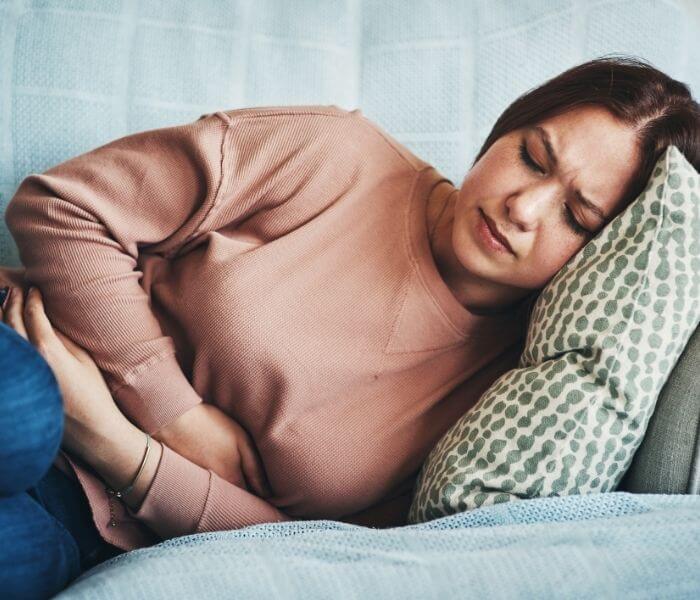6 mins read
Endometriosis Awareness – Why More Needs to Be Done

- Endometriosis – The Big Female Health Issue
- What is Endometriosis?
- What Causes Endometriosis?
- Genetics
- Immune dysfunction
- Metaplasia
- Retrograde menstruation
- Lymphatic or circulatory system
Endometriosis can have a serious impact on a woman’s quality of life – from experiencing chronic pain to lack of energy and depression. It also impacts a woman’s ability to fall pregnant.
Because the symptoms can vary from woman to woman and can overlap with other health conditions, endometriosis can be difficult to diagnose. The average length of time to diagnosis is over 7 years. Not only does diagnosis take such a long time, but many women do not seek medical help for their symptoms.
Endometriosis – The Big Female Health Issue
Approximately 1.5 million women in the UK have endometriosis [1]. The condition affects girls and women from puberty to menopausal age and can affect any race or ethnicity. Statistics released by Endometriosis UK found that 62% of women in the UK aged between 16 and 54 wouldn’t go and see a doctor with symptoms of endometriosis because:
- they think that the symptoms are a normal part of having a period
- they don’t think it’s serious enough to take up a doctor’s time
- they’re embarrassed
- they don’t think they would be taken seriously [2].
Living with endometriosis can be physically and emotionally draining. The APPG on Endometriosis Inquiry Report 2020 found that:
- 95% of respondents stated that the symptoms of endometriosis had negatively or very negatively affected their wellbeing
- 81% felt their mental health had been negatively affected
Endometriosis is the second most common gynaecological condition affecting women. With symptoms having such a big impact on women’s life, more needs to be done to not only raise awareness but to support women in getting the help they need – and quickly. So, what exactly is endometriosis and what causes it?
What is Endometriosis?
Endometriosis is a condition where cells like the ones that line the womb are found in other places in the body, such as the fallopian tubes and ovaries [1].
Every month, just like the cells lining the womb, these cells build up, break down, and then bleed. However, unlike the womb cells which leave the body as part of a woman’s monthly period, the blood from the cells found in other parts of the body has nowhere to go. It is this that causes the pain women with endometriosis experience.
What Causes Endometriosis?
The exact cause of endometriosis is not known but there are many theories that may help to explain why the condition develops in some women. They include:
- environmental factors
- genetic predisposition
- immune dysfunction
- metaplasia
- retrograde menstruation
- spreading through the lymphatic or circulatory system
Environmental factors
Animal studies have shown that exposure to specific environmental toxins can lead to the development of endometriosis [5]. This is yet to be proven in humans.
Genetics
There is some evidence that suggests the condition can be passed down through families [6]. Some ethnic groups are more susceptible to endometriosis but the reasons for this are still unclear.
Immune dysfunction
There is a suggestion that the body’s immune system could be a cause of endometriosis. Some studies show that women who have the condition have a reduced defence against other conditions [7].
Metaplasia
Metaplasia is where one cell type can turn into a different type of cell. It usually happens in response to inflammation and allows cells to better adapt to their surrounding environment. It may help to explain why endometriosis cells appear in other parts of the body or why some men develop them when they take certain hormonal treatments [7].
Retrograde menstruation
When you have a period, the womb lining leaves the body via the vagina but some of the endometrium flows backwards, through the fallopian tubes. Although it has been suggested that everyone who has a period experiences some form of retrograde menstruation, most are able to clear the tissue. However, in some cases the endometrial cells deposit on the organs of the pelvis, leading to endometriosis [7].
Lymphatic or circulatory system
Another theory is that cells from the womb lining can travel around the body either in the blood or the lymphatic system [4].
Although all these proposed theories could offer some explanation about why or how endometriosis occurs, none of them present a full rationale. Instead, it is likely that the condition is caused by a mixture of these factors.
Endometriosis Symptoms
The symptoms of endometriosis can vary from woman to woman. Some experience just mild symptoms which do not interfere with their everyday lives, whereas others are more severely affected.
According to the NHS, the main symptoms of endometriosis include:
- severe period pain that stops you from carrying out normal activities
- lower stomach or back pain which is often worse during your period
- pain during or after sex
- nausea, constipation or diarrhoea
- blood in your urine during your period
- pain when going to the toilet during your period
- difficulty falling pregnant [4]
How is Endometriosis Diagnosed?
There is currently no endometriosis blood test available for diagnosing the condition, but they can be used to rule out other conditions. The only way endometriosis can be diagnosed is by a laparoscopy. A laparoscopy is performed by a gynaecologist and is where a camera called a laparoscope is inserted into a small cut in the abdomen to look for endometriosis tissue in the pelvis.
Getting a diagnosis for endometriosis can be difficult because many of the symptoms overlap with other conditions or they can differ between women.
Because of this, achieving a diagnosis can be a lengthy process. The average time it takes from first seeing a doctor about symptoms to getting a diagnosis is 7.5 years. This is far too long given the impact the condition has on women’s quality of life and further demonstrates the inequality in women’s health provision.
It is important to see a doctor if you think you are experiencing the symptoms of endometriosis. It’s helpful to keep a diary of your symptoms and learn as much as you can about the condition so you can guide the conversation with your GP and ask for the support you need.
There are many reasons why endometriosis can take time to be diagnosed. This can include the misconception that it is “normal” for women to have pain. Endometriosis is difficult to distinguish from other chronic pain conditions. There is not a reliable non-invasive biomarker. The key point is that endometriosis presents with cyclical pain. So having an open discussion with your GP is really important to explore this possible diagnosis.
Living With Endometriosis
There is currently no cure available for endometriosis but there are treatments available that can help women cope with the symptoms, such as:
- painkillers such as paracetamol and ibuprofen
- hormone medicines and contraceptives
- surgery
Conclusion
Endometriosis severely impacts the lives of many women in the UK. Lack of awareness and reluctance to visit a GP are issues women experience. But for those who do visit their GP, some find that they are prescribed hormonal contraception for the symptoms without the cause for symptoms being discussed, which means they are living with the condition for years without being aware of it. Even if the symptoms are investigated, it can take years for a formal diagnosis.
Much more needs to be done to support women’s hormone health so conditions like endometriosis are diagnosed quicker and better support provided.
Endometriosis UK offers free information and vital support services to anyone who is affected by the condition.
Read Next: Endometriosis: What Are The 4 Stages & Symptoms?>>
- Health scores calculated
Close
Article references
-
Sofo, V et al. (2015). Correlation Between Dioxin and Endometriosis: An Epigenetic Route to Unravel the Pathogenesis of the Disease. Arch Gynecol Obstet.
-
Rahmioglu, N., Montgomery, G, W & Zondervan, K, T. (2015). Genetics of Endometriosis. Women’s Health: 11(5), pp 577-586.
This information has been medically reviewed by Dr Nicky Keay
Nicola has extensive clinical and research experience in the fields of endocrinology and sport and exercise medicine. Nicky is a member of the Royal College of Physicians, Honorary Fellow in the Department of Sport and Exercise Sciences at Durham University and former Research Fellow at St. Thomas' Hospital.

Dr Nicky Keay
BA, MA (Cantab), MB, BChir, MRCP.
Related articles
Like this article? Here are some more based on similar topics.





